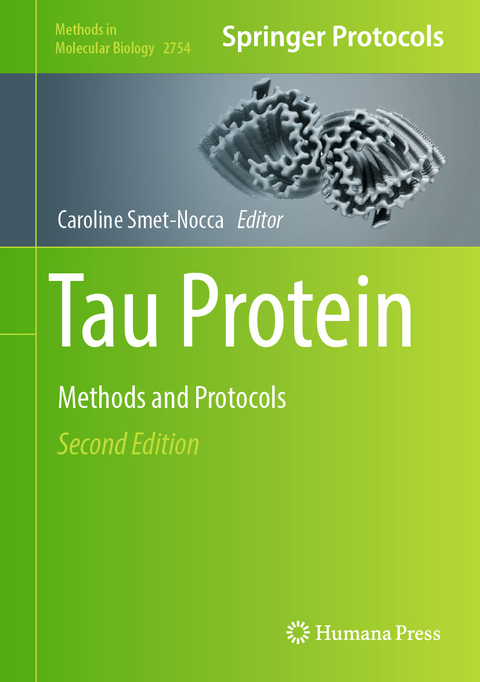
Tau Protein
Springer-Verlag New York Inc.
978-1-0716-3628-2 (ISBN)
Cutting-edge and comprehensive, Tau Proteins: Methods and Protocols, Second Edition is a valuable tool for any researcher interested in learning more about this important and developing field related to Tau protein as a relevant and attractive target for neurodegeneration therapies.
Characterization of Post-Translationally Modified PHF-1 Tau Peptides using Gaussian Accelerated Molecular Dynamics Simulation.- Interaction of Tau with G-Protein Coupled Purinergic P2Y12 Receptor by Molecular Docking and Molecular Dynamic Simulation.- Structural Flexibility of Tau in its Interaction with Microtubules as Viewed by Site-Directed Spin Labelling EPR Spectrocopy.- Cryo-Electron Microscopy and Molecular Modelling Methods to Characterize the Dynamics of Tau-Bound to Microtubules.- Assays for the Screening and Characterization of Tau Aggregation Inhibitors.- Photo-Excited Dyes: Emerging Technique Against Tau Protein Aggregation.- Sedimentation and Laser Light Scattering Methods for Quantifying Synthetic Tau Aggregation Propensity.- Recombinant Production and Characterization of VHHs/Nanobodies Targeting Tau to Block Fibrillar Assembly.- Tau Oligomers as Pathogenic Seeds: Preparation, Characterization, and Propagation In Vitro and InVivo.- Preparation of Tau Condensates by Liquid-Liquid Phase Separation to Study Tau Amyloid Aggregation.- Biochemical and Biophysical Characterization of Tau and α-Linolenic Acid Vesicles In Vitro.- Detection of Small-Molecule Interactions with Fibrillar Tau Protein Aggregates Using Microscale Thermophoresis.- Quantification of Methylation and Phosphorylation Stoichiometry.- The O-GlcNAc Modification of Recombinant Tau Protein and Characterization of the O-GlcNAc Pattern for Functional Study.- Phosphorylation of Tau Protein by CDK2/cyclin A and GSK3β Recombinant Kinases: Analysis of Phosphorylation Patterns by Nuclear Magnetic Resonance Spectroscopy.- Western Blot of Tau Protein from Mouse Brains Extracts: How to Avoid Signal Artifacts.- Methods for Biochemical Isolation of Insoluble Tau in Rodent Models of Tauopathies.- A Method to Collect Cerebrospinal Fluid from Mouse Cisterna Magna to Determine Extracellular Tau Levels.- Detectionof Glymphatic Outflow of Tau from Brain to Cerebrospinal Fluid in Mice.- Differential Regulation of Neurotrophic Factors during Pathogenic Tau-Aggregation in a Tau Transgenic Mouse Model for Alzheimer’s Disease: A Protocol for Double-Labeling mRNA by In Situ Hybridization and Protein Epitopes by Immunohistochemistry.- Intranasal Nose-to-Brain Drug Delivery Via the Olfactory Region in Mice: Two In-Depth Protocols for Region-Specific Intranasal Application of Antibodies and for Expression Analysis of Fc Receptors Via In Situ Hybridization in the Nasal Mucosa.- Detecting and Validating MAPT Mutations in Neurodegeneration Patients and Analysis of Exon Splicing Consequences.- Measuring Antibody-Mediated Tau Fibril Uptake in Microglia by Flow Cytometry.- Super-Resolution Imaging of Tau Proteins in Isolated and Immobilized Brain Synaptosomes.- Purinergic Receptor P2Y12-Mediated Tau Internalization in Microglia.- Alpha-Linolenic Acid Induces Microglial Activation and Extracellular Tau Internalization.- Identification of Tau Toxicity Modifiers in the Drosophila Eye.- Tracking Tau in Neurons: How to Transfect and Track Exogenous Tau in Primary Neurons.- Tracking Tau in Neurons: How to Grow, Fix, and Stain Primary Neurons for the Investigation of Tau in All Developmental Stages.- Differentiating SH-SY5Y Cells into Polarized Human Neurons for Studying Endogenous and Exogenous Tau Trafficking: Four Protocols to Obtain Neurons with Noradrenergic, Dopaminergic, and Cholinergic Properties.- Cultivation, Differentiation, and Lentiviral Transduction of Human Induced Pluripotent Stem Cell (hiPSC)-Derived Glutamatergic Neurons for Studying Human Tau.- Optimized Calcium-Phosphate Based Co-Transfection of Tau and tdTomato into Human iPSC-Derived Neurons for the Study of Intracellular Distribution of Wildtype and Mutant Human Tau.- Studying Microtubule Dynamics in Human Neurons: 2D Microtubule Tracing and Kymographs iniPSC- and SH-SY5Y-Derived Neurons for Tau Research.- A Brain Ischemia-Reperfusion Model for the Study of Tau Phosphorylation and O-GlcNAcylation.
| Erscheinungsdatum | 27.03.2024 |
|---|---|
| Reihe/Serie | Methods in Molecular Biology |
| Zusatzinfo | 1 Illustrations, black and white; XVIII, 608 p. 1 illus. |
| Verlagsort | New York, NY |
| Sprache | englisch |
| Maße | 178 x 254 mm |
| Themenwelt | Naturwissenschaften ► Biologie ► Biochemie |
| Naturwissenschaften ► Chemie | |
| Schlagworte | cryo-electron microscopy • Intracellular Tau Protein • microtubules • phosphorylation patterns • UVRR |
| ISBN-10 | 1-0716-3628-6 / 1071636286 |
| ISBN-13 | 978-1-0716-3628-2 / 9781071636282 |
| Zustand | Neuware |
| Informationen gemäß Produktsicherheitsverordnung (GPSR) | |
| Haben Sie eine Frage zum Produkt? |
aus dem Bereich


